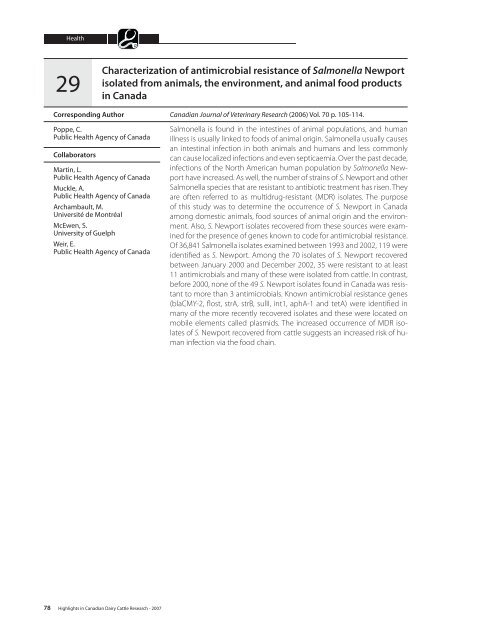Health29Characterization of antimicrobial resistance of Salmonella Newportisolated from animals, the environment, and animal food productsin CanadaCorresponding AuthorPoppe, C.Public Health Agency of CanadaCollaboratorsMartin, L.Public Health Agency of CanadaMuckle, A.Public Health Agency of CanadaArchambault, M.Université de MontréalMcEwen, S.University of GuelphWeir, E.Public Health Agency of CanadaCanadian Journal of Veterinary Research (2006) Vol. 70 p. 105-114.Salmonella is found in the intestines of animal populations, and humanillness is usually linked to foods of animal origin. Salmonella usually causesan intestinal infection in both animals and humans and less commonlycan cause localized infections and even septicaemia. Over the past decade,infections of the North American human population by Salmonella Newporthave increased. As well, the number of strains of S. Newport and otherSalmonella species that are resistant to antibiotic treatment has risen. Theyare often referred to as multidrug-resistant (MDR) isolates. The purposeof this study was to determine the occurrence of S. Newport in Canadaamong domestic animals, food sources of animal origin and the environment.Also, S. Newport isolates recovered from these sources were examinedfor the presence of genes known to code for antimicrobial resistance.Of 36,841 Salmonella isolates examined between 1993 and 2002, 119 wereidentified as S. Newport. Among the 70 isolates of S. Newport recoveredbetween January 2000 and December 2002, 35 were resistant to at least11 antimicrobials and many of these were isolated from cattle. In contrast,before 2000, none of the 49 S. Newport isolates found in Canada was resistantto more than 3 antimicrobials. Known antimicrobial resistance genes(blaCMY-2, flost, strA, strB, sulII, int1, aphA-1 and tetA) were identified inmany of the more recently recovered isolates and these were located onmobile elements called plasmids. The increased occurrence of MDR isolatesof S. Newport recovered from cattle suggests an increased risk of humaninfection via the food chain.78 Highlights in Canadian Dairy Cattle Research - 2007
Health30Influence of the genotype of Staphylococcus aureus, determinedby pulsed-field gel electrophoresis, on dry-period elimination ofsubclinical mastitis in Canadian dairy herdsCorresponding AuthorDingwell, R.T.University of GuelphCollaboratorsLeslie, K.E.University of GuelphSabour, P.M.AAFC Food Research ProgramLepp, D.AAFC Food Research ProgramPacan, J.C.University of GuelphCanadian Journal of Veterinary Research (2006) Vol. 70 p. 115-120.Intramammary administration of antibiotics to cows at dry-off (dry cowtherapy: DCT) is a recommended and widely accepted practice. DCT, properlyapplied, can eliminate environmental pathogens that cause mastitisand prevent 50 to 80% of new intramammary infections, compared to notusing DCT. Of the infections that DCT does not prevent, many are causedby Staphlococcus aureus. The objectives of this study were to compare theefficacy of 2 different DCT antibiotics in reducing new S. aureus infectionsand to determine if different strains of S. aureus were more or less susceptibleto DCT. Three strains of S. aureus were classified by pulsed-field gelelectrophoresis and identified as lineage groups A, D and F. Cows infectedby group D had higher somatic cell scores at last DHI test day before dryoffthan those infected by groups A or F. Of the 2 antibiotics tested, tilmicosinphosphate cured significantly more cases (74%) than did benzathinecloxacillin (53%). Among the 3 lineage groups, significantly more of theinfections by group D (87%) were cured than those of group A (46%) orF (33%) when benzathine cloxacillin was used. There were no differencesin cure rates between groups when tilmicosin phosphate was used. Theresults demonstrate differences in antibiotic efficacy and susceptibility totreatment of different S. aureus lineage groups.31Ventral laparoscopic abomasopexy on adult cowsCorresponding AuthorBabkine, M.Université de MontréalCollaboratorsDesrochers, A.Université de MontréalBouré, L.University of GuelphHelie, P.Université de MontréalCanadian Veterinary Journal (2006) Vol. 47 p. 343-348.Left displaced abomasum (LDA) is a common disorder of dairy cows inearly lactation, reducing productivity and increasing the cow’s risk of beingculled. Several alternative surgical procedures are used to correct the displacementand anchor the abomasum into its normal position. Althoughthe success rate of these procedures is in the 90% range, all require thatan incision be made in the side or bottom of the body cavity. Complicationsinclude infection of the wound, herniation through the wound andgeneralized infection inside the body cavity (peritonitis). An alternative isblind-stitch fixation and, although its success rate is similar to the surgicalprocedures, this technique can precipitate additional, more severe complicationssuch as partial obstruction of the stomach and inadvertent fixationof another part of the digestive tract. This paper describes a procedure forabomasal fixation (abomasopexy) using a laparoscope, a 42 cm long rigidfibre optic device which allows internal organs to be viewed. The laparoscopeis used to guide the placement of 4 sutures through very small incisionsin the abdominal wall. The procedure was performed on 10 cowswith no major complications and its success was evaluated 3 months laterusing the laparoscope. The authors suggest that the technique could beroutinely applied to the correction of LDA.Health 79





